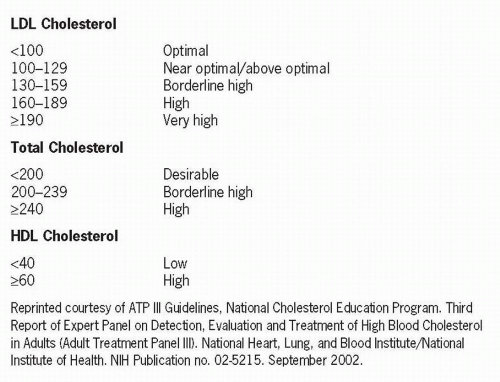Dyslipidemia and Atherosclerosis
Dyslipidemia, also called hyperlipidemia, is an increased level of plasma lipid concentration made up of cholesterol and/or triglycerides. These lipid levels have been well documented in their relationship to the development of atherosclerotic vascular disease, especially coronary artery disease (CAD), cerebrovascular disease, and peripheral vascular disease. Alterations in the lipid profile are associated with the increased risk of CAD.
It is estimated that approximately 50% of Americans have dyslipidemia, with a higher incidence among diabetics, those with hypertension, and African Americans. Familial or inherited forms of hypercholesterolemia occur in approximately 1 in 500 persons. More than 100 million Americans have borderline high levels of cholesterol.
Atherosclerosis is a chronic disease characterized by thickening and hardening of the arterial wall. Lesions/plaques containing lipids develop and calcify, causing vessel obstruction, platelet aggregation, and abnormal vasoconstriction.
Atherosclerotic heart disease is the leading cause of death in the United States, although there has been a gradual decline in those deaths possibly due to earlier intervention and improved medical therapies. Atherosclerotic cerebrovascular disease is the leading cause of stroke, accounting for more than 40% of deaths in the United States. Peripheral vascular disease and its increased incidence of complications is common among those persons with diabetes mellitus and atherosclerosis.
Table 33-1 Therapeutic Life-Style Changes | ||||||||||||||||||
|---|---|---|---|---|---|---|---|---|---|---|---|---|---|---|---|---|---|---|
| ||||||||||||||||||
The risk factors for atherosclerotic vascular disease include dyslipidemia, cigarette smoking, hypertension, male or postmenopausal female, age > 50, diabetes/insulin resistance, increased serum fibrinogen, and hyperhomocystinemia. Other contributory factors include a diet high in saturated fat, obesity, sedentary life-style, and family history of atherosclerosis.
 Atherosclerotic cerebrovascular disease is the leading cause of stroke, accounting for more than 40% of deaths in the United States. Peripheral vascular disease and its increased incidence of complications are common among those persons with diabetes mellitus and atherosclerosis.
Atherosclerotic cerebrovascular disease is the leading cause of stroke, accounting for more than 40% of deaths in the United States. Peripheral vascular disease and its increased incidence of complications are common among those persons with diabetes mellitus and atherosclerosis.Stay updated, free articles. Join our Telegram channel

Full access? Get Clinical Tree


Get Clinical Tree app for offline access

